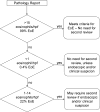Value of an Additional Review for Eosinophil Quantification in Esophageal Biopsies
- PMID: 25633495
- PMCID: PMC4483145
- DOI: 10.1097/MPG.0000000000000740
Value of an Additional Review for Eosinophil Quantification in Esophageal Biopsies
Abstract
Eosinophilic esophagitis (EoE) requires a peak count of 15 eosinophils per high-power field (hpf). Herein, the peak eosinophil count specified by a pathologist was compared with the second review of a research assistant. Of 477 biopsies, 106 had a peak count between 1 and 14 eosinophils/hpf cited in the pathology report, and 23/106 (22%) had ≥15 eosinophils/hpf on second review. The pathology report detected potential EoE with 99% specificity, but 80% sensitivity. As such, an additional review of esophageal biopsies yields higher eosinophil counts in ∼5% of cases. We propose that biopsies with a count between 1 and 14 eosinophils/hpf require further investigation because ∼22% may yield a potential EoE diagnosis.
Conflict of interest statement
No conflicts of interest were declared for the remaining authors.
Figures


References
-
- Liacouras CA, Furuta GT, Hirano I, et al. Eosinophilic esophagitis: updated consensus recommendations for children and adults. J Allergy Clin Immunol. 2011 Jul;128(1):3–20.e26. quiz 21–22. - PubMed
-
- Furuta GT, Liacouras CA, Collins MH, et al. Eosinophilic esophagitis in children and adults: a systematic review and consensus recommendations for diagnosis and treatment. Gastroenterology. 2007 Oct;133(4):1342–1363. - PubMed
-
- Sperry SL, Shaheen NJ, Dellon ES. Toward uniformity in the diagnosis of eosinophilic esophagitis (EoE): the effect of guidelines on variability of diagnostic criteria for EoE. Am J Gastroenterol. 2011 May;106(5):824–832. quiz 833. - PubMed
-
- Dellon ES, Aderoju A, Woosley JT, et al. Variability in diagnostic criteria for eosinophilic esophagitis: a systematic review. Am J Gastroenterol. 2007 Oct;102(10):2300–2313. - PubMed
Publication types
MeSH terms
Grants and funding
LinkOut - more resources
Full Text Sources
Medical
Research Materials

